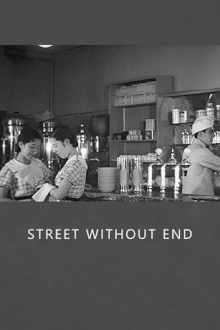This is only the second film by Mikio Naruse and it goes all the way back to the silent era. It’s probably unnecessary unless you’re being a completionist but I was curious about Japan’s silent film era and this does feature imagery from a very distant in the past Tokyo. I don’t particularly like the story or the characters but I was surprised by how strong the female characters shown here are and how much agency they have. As to be expected from Naruse, the outcome is bittersweet at best and the characters face numerous crises, yet they never break down nor turn against one another. Quite remarkable for a work from that era.
Sugiko along with her friend and roommate Kesako work as waitresses in an American-style cafe in Ginza, Tokyo. Occupying the room opposite them in the boarding house is Shinkichi, a poor artist who is interested in Kesako. Sugiko already has a boyfriend Machio but his family arranges for him to marry another girl from back home so he quickly proposes to her instead. The next morning, she is approached by a talent scout from a film studio who wants her to be an actress. Kesako envies her multiplicity of options but before Sugiko can make a decision, she is hit by a car outside the cafe. She is only lightly bruised however and the driver Hiroshi is the heir of a rich family who is very apologetic. Machio leaves town to marry the other girl and Kesako takes up the acting job. Meanwhile Hiroshi starts dating Sugiko despite the objections of his mother and his sister about her being from a lower social class. She eventually accepts Hiroshi’s marriage proposal even though her brother Koichi who has come to find work in Tokyo is against it too.
All these are pretty standard story tropes and it is admittedly a struggle at times to not be bored especially since there is quite a lot of dialogue for a silent film and you need to keep up with reading what they say. Its very age is a point in its favor however and I found it rather fascinating to see the Tokyo of nearly a hundred years ago. I further note that this film seems to associate American, or least Western influences, with modernity and the theme here is all about Japan adapting to the modern world and an urban lifestyle. The closest thing we have to antagonists here are Hiroshi’s family who represent hidebound tradition and resistance to change. Being a waitress might be a lowly job, but Naruse depicts Sugiko and her friends living happy lives there, much more so than after she marries Hiroshi. So I interpret this as being pro-modernity and largely pro-Western in outlook, quite a refreshing difference from other filmmakers and only possible I think because this was made before World War 2.
Another remarkable aspect of this film is that it shows the female characters as being stronger than the male ones. Both Machio and Hiroshi ultimately fail to stand up to their families to live the lives that they truly want. Shinkichi is too weak and poor to properly court Kesako and in the end, it is her who helps him get a better job. Kesako does take the acting job when Sugiko is slow to act on the offer but proactively apologizes for it and the latter never allows it to affect their friendship. Both characters seem perfectly content in being working women who are able to support themselves. Sugiko tries her best to be accepted by her mother-in-law and sister-in-law but also isn’t afraid to stand up for herself. It’s far ahead of its time in depicting progressive values and seems to show women thriving in the modern city.
I wouldn’t say this is interesting enough or enjoyable enough to be worth watching unless you’re a film historian or something. I appeciated it as part of an ongoing effort to gain a deeper appreciation of Naruse’s body of work and how different he was from his contemporaries. In that regard, I was not disappointed.
